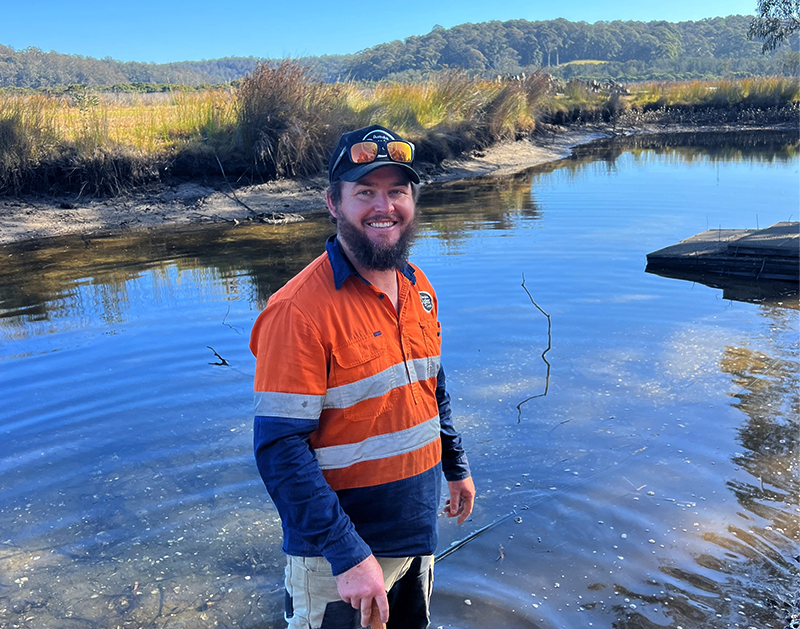Erosion poses a significant threat to coastal ecosystems, and oyster farms are no exception. With rising sea levels and increasing storm events, protecting these valuable habitats becomes crucial. Fortunately, sustainable solutions exist that not only combat erosion but also support the growth of oyster populations. One such solution is the use of coir logs, which offer a cost-effective, eco-friendly, and efficient approach to erosion prevention in oyster farms. In this blog post, we will explore how coir logs can be utilised as a sustainable solution to safeguard oyster farms from erosion.
Understanding Erosion at Oyster Farms:
Oyster farms play a vital role in supporting marine biodiversity and local economies. However, their location in coastal areas makes them vulnerable to erosion caused by tidal currents, wave action, and storm surges. Erosion can lead to the loss of productive oyster beds, coastal land degradation, and reduced water quality. Consequently, finding effective erosion prevention techniques is essential to the long-term sustainability of oyster farming operations.


Above: Photos of the erosion occurring at our Bermagui oyster farm
Introducing Coir Logs:
Coir logs, often referred to as coconut fiber logs, are erosion control devices made from the fibrous outer husk of coconuts. These logs are lightweight, flexible, and biodegradable, making them an ideal choice for environmentally conscious erosion prevention. By mimicking natural riparian conditions, coir logs effectively stabilise slopes, control sediment runoff, and promote vegetation growth, which is crucial for oyster farming areas.

Above: Photos of the Coir Logs from Eco Spills we installed at our Bermagui oyster farm to help address erosion concerns and prevent future damage.
Benefits of Coir Logs for Oyster Farms:
Erosion Control: Coir logs act as natural barriers, dissipating the energy of waves and tidal currents, thereby minimising erosion and protecting the oyster beds from being washed away.
Sediment Trapping: The permeable structure of coir logs allows water to pass through while trapping sediment. This process helps reduce turbidity in the water, maintaining optimal conditions for oyster growth and enhancing water quality.
Vegetation Support: Coir logs provide a stable foundation for the establishment of vegetation. By encouraging the growth of salt-tolerant plants or other coastal grasses, coir logs enhance the overall stability of the shoreline and facilitate the formation of natural buffers against erosion. Our farmers can also plant the mangrove shoots they collect from our floating bags for further restoration and vegetal support.
Biodegradability: As a natural product, coir logs are biodegradable, ensuring minimal environmental impact. Over time, the logs decompose, enriching the soil with organic matter and nutrients that benefit both oyster growth and the surrounding ecosystem.
Cost-Effective Solution: Coir logs offer a cost-effective alternative to traditional erosion control methods. Their affordability, ease of installation, and long-term effectiveness make them an attractive choice for oyster farmers with limited resources.


Above: Following a site assessment, the coir logs were installed in two sections using different techniques to ensure maximum effectiveness.
Implementation and Best Practices:
To maximise the benefits of coir logs for erosion prevention at our oyster farms, it is crucial to follow a few best practices:
Site Assessment: Conduct a thorough assessment of the site to determine the most vulnerable areas prone to erosion. This will help identify where coir logs should be strategically placed.
Proper Installation: Ensure that coir logs are securely anchored in place to withstand wave action and tidal forces. Use biodegradable stakes or natural materials to secure the logs while minimising environmental impact.
Vegetation Selection: Choose salt-tolerant vegetation species that can thrive in the oyster farming environment.
Monitoring and Maintenance: Regularly monitor the coir logs and vegetation to ensure their effectiveness in erosion prevention. Maintain a consistent maintenance schedule to remove debris and facilitate plant growth.

Above: Our Bermagui Farm Manager Andy, Batemans Bay Office Manager Belinda and Aquaculture Compliance Officer Scott installing the coir logs as part of our erosion prevention project at our Bermagui oyster farm.
Conclusion:
Protecting our oyster farms from erosion is essential for maintaining the health and sustainability of coastal ecosystems and the long-term sustainability of our oyster farming operations. Coir logs offer an eco-friendly and cost-effective solution that addresses erosion. By stabilising slopes, controlling sediment runoff, and supporting vegetation establishment, coir logs provide a valuable tool for our oyster farmers to mitigate the impacts of erosion. Embracing sustainable solutions like coir logs enables us to safeguard these vital ecosystems while ensuring a prosperous future for oyster farming and coastal communities.





)
)
)
)
)
)
)
)
)
)
)
)
)
)
)
)
)
)
)
)
)
)
)
)
)
)